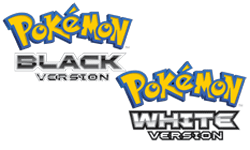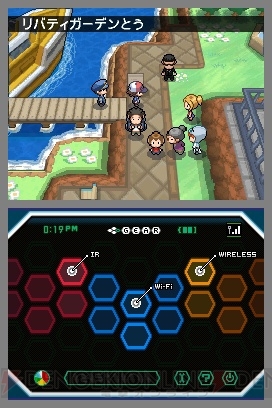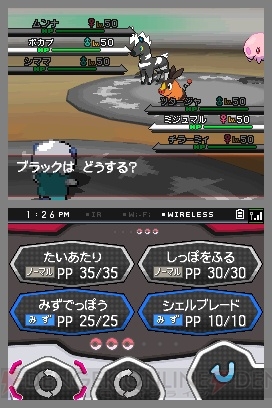|
|

|
PLATFORM
|
DS
|
BATTLE SYSTEM
|

|
INTERACTION
|

|
ORIGINALITY
|

|
STORY
|

|
MUSIC & SOUND
|

|
VISUALS
|

|
CHALLENGE
|
Moderate
|
COMPLETION TIME
|
20-40 Hours
|
|
OVERALL

|
+ TMs can be used over and over.
+ Can finally use WPA protocol to connect to the internet.
+ Story is surprisingly more involved than usual.
+ Lots of post-game content.
- Higher-than-normal encounter rate.
- Menu is a step backwards.
|
Click here for scoring definitions
|
|
|
What do you do with a series after four generations of minor upgrades and remakes? The Pokémon series has been one of the best-selling, most highly-regarded RPG franchises for almost thirteen years now, and the last generation brought the total number of catchable critters to almost five-hundred. With Pokémon White, Game Freak's primary goal was to reboot the franchise, to reinvent the wheel so to speak. In many ways they succeeded: Pokémon White puts everyone back on the same even playing-field they were on when Blue/Red first arrived all those years ago, with the main game containing nothing but new pokémon. The game also has a much stronger focus on story than ever before, touching on themes that we've been joking about for years. However, keep in mind that this is still Pokémon, and in this world certain things never change.
Pokémon White's story branches out a bit from what the series is used to. Although players still take control of a young boy or girl setting out on a journey to collect gym badges and fill a pokédex, the game also includes two rivals rather than just one. Each rival has a unique personal journey, and players can expect to run into and even team up with both of them as the game progresses. One of those rivals in particular explores an area of the Pokémon universe that many people have called into question: what kind of parent would let their ten year old kid run off on a journey around the country on his own? Apparently not all of them do, as the father of one of these rivals chases after her to bring her home.
Like other Pokémon games, White also has a shadowy group of ne'er-do-wells who try to steal other people's pokémon. In this case, Team Plasma actually takes the form of animal rights activists, stealing pokémon from trainers so they can release them into the wild. Naturally, the game pits those ideals against the same ideals that have been the backbone of the series since the beginning, creating a story that's much more interesting to follow than any other game in the series with the exception of the Pokémon Ranger spinoffs. And taking a page from 2000's Gold/Silver versions, the story continues even after the credits roll. New cities and dungeons become available in the post-game, and an old friend from Pokémon Platinum may even "look" in to see how you're doing.
The core of the gameplay, Pokémon's type-driven turn-based combat, has changed significantly less than other parts of the game. The same basic principles as usual apply: the player has a team of six pokémon they can send into one-on-one battles with other trainers' pokémon. Each pokémon has up to two of seventeen possible types, each with its own set of strengths and weaknesses. Wild pokémon can also be found in tall grass and in caves or in the water, and these can be captured and added to the player's team.
 The C-Gear looks cool, but it's actually kind of useless.
The C-Gear looks cool, but it's actually kind of useless.
|
|
The only new aspect of Pokémon White's combat system is the addition of triple battles, where each side sends out three pokémon to fight instead of just one. The pokémon on each side line up in a row, but each one can only attack the pokémon directly across or adjacent to it, making it a bit more complex than the typical pokémon battle. Unfortunately, it's very difficult to plan any kind of strategy around this as it's impossible to know in advance what pokémon an opponent will be using. These battles are also exceedingly rare, with only a small handful occurring over the course of the game. Double battles, introduced in Pokémon Emerald/Ruby, now have an increased presence thanks to a new type of "taller" grass, where it's possible to encounter two wild pokémon at the same time.
Outside of combat, White brings significant changes and improvements with it. The entire game is more streamlined than ever before, with a fairly linear path set out before the player for the duration of the main game. It's much harder to get lost in Pokémon White than in previous incarnations of the series. TMs, items used to teach pokémon new moves, have also seen a rather major change. While previously these items disappeared after being used, they can now be used over and over again, leaving the player free to experiment to his hearts content. To balance this out, TMs are also much rarer. The few that can be purchased are exceedingly expensive, but most of the nearly one-hundred in the game can simply be found lying around, or will be given to the player for completing certain tasks.
While the game has seen an increase in linearity for the primary story, that isn't to say that the linearity persists. On the contrary, the post-game is entirely about exploration. Players who take the time to re-explore the entirety of the game's world will find a myriad of new areas off the beaten path, making it that much more appealing. The experience system has also been revamped, and now scales based on the comparative levels of the two opponents. This makes it much harder to grind to high levels, but simultaneously much easier to train new pokémon.
 Triple battles are unfortunately fairly rare.
Triple battles are unfortunately fairly rare.
|
|
Not all the changes are positive, however. Pokémon Heart Gold/Soul Silver's fantastic, touch-driven main menu has been supplanted by a relatively weak user interface whose focus is entirely dedicated to its always-on wireless functionality. For those who use the wireless functionality regularly, this is great, but most players will likely find that it goes largely ignored and unused. That said, Pokémon White finally introduces DSi-specific functionality, primarily the ability to connect to the internet using WPA and WPA2 wireless protocols. For players who struggled with previous titles' reliance on the outdated WEP protocol, this will be a huge relief. The encounter rate in Pokémon White also seems much higher than previous games, and it's not uncommon to run into wild pokémon after a single step. Repel items, which temporarily eliminate random encounters, are much more vital than ever before.
As usual, Pokémon's visuals aren't particularly amazing, but White is certainly a major step up compared to previous games. 3D environments are much more common, and the sprites are more detailed than ever before. Environments also undergo radical visual updates as the seasons change, a new feature in White that occurs roughly once a month. The visual upgrades are particularly noticeable in battle. Pokémon and their trainers are now partially animated and even have different appearances when under the effects of certain status ailments.
The soundtrack is also pleasantly surprising, and is easily the best Pokémon soundtrack to date. Rather than rehashing the same tired songs over and over, the music sounds fresh and unexpectedly complex in places. Granted, remixes of certain Pokémon staples, such as the pokémon center theme, still have a home in White, but the majority of the soundtrack is new and extremely pleasant. Sound effects are still the game's weak point, unfortunately; the tinny, unidentifiable creature-cries of the past haven't gone anywhere, and after five generations and over six-hundred pokémon, the chances of this ever changing are almost nonexistent.
Pokémon White is yet another terrific Pokémon game, certain to please veterans and newcomers alike. While the changes made to the game's formula are not ground-breaking, they are nonetheless revisions that have been a long time coming. Pokémon White is a fair bit shorter than the last generation, with the main story being easily completable in roughly thirty hours, but the post-game content can extend that by quite a bit, especially given how much is present in this version. While the traditional third version is sure to come out sometime next year, there's not much more polish that can be added to this iteration. If you're a Pokémon fan, then you should be playing Pokémon White.
Review Archives
|









